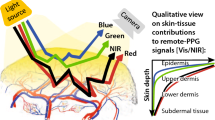Abstract
This report evaluates the efficacy of reflected-type green light photoplethysmography (green light PPG). Transmitted infrared light was used for PPG and the arterial pulse was monitored transcutaneously. The reflected PPG signal contains AC components based on the heartbeat-related signal from the arterial blood flow and DC components, which include reflectance and scattering from tissue. Generally, changes in AC components are monitored, but the DC components play an important role during heat stress. In this study, we compared the signal of green light PPG to infrared PPG and ECG during heat stress. The wavelengths of the green and infrared light were 525 nm and 880 nm, respectively. Experiments were performed on young healthy subjects in cold (10°C), hot (45°C), and normal environments. The pulse rates were compared among three measurement devices and the AC and DC components of the PPG signal were evaluated during heat stress. The pulse rates obtained from green light PPG were strongly correlated with the R–R interval of an electrocardiogram in all environments, but those obtained from infrared light PPG displayed a weaker correlation with cold exposure. The AC components were of similar signal output for both wavelengths during heat stress. Also, the DC components for green light PPG were similar during heat stress, but showed less signal output for infrared light PPG during hot exposure. The main reason for the reduced DC components was speculated to be the increased blood flow at the vascular bed. Therefore, reflected green light PPG can be useful for pulse rate monitoring because it is less influenced by the tissue and vein region.






Similar content being viewed by others
References
Hertzman, A. B., The blood supply of various skin areas as estimated by the photoelectric plethysmograph. Am. J. Physiol. 124:328–340, 1938.
Allen, J., Photoplethysmography and its application in clinical physiological measurement. Physiol. Measure. 28:1–39, 2007.
Futran, N. D., Stack, B. C., Jr., Hollenbeak, C., and Scharf, J. E., Green light photoplethysmography monitoring of free flaps. Arch. Otolaryngol. Head Neck Surg. 126:659–662, 2000.
Asada, H. H., Shaltis, P., Asada, H. H., Shaltis, P., Reisner, A., Rhee, S., and Hutchinson, R. C., Mobile monitoring with wearable photoplethysmographic biosensors. IEEE Eng. Med. Biol. Mag. 22:28–40, 2003.
Anderson, R. R., and Parrish, J. A., The optics of human skin. J. Invest. Dermatol. 77:13–19, 1981.
Giltvedt, J., Sita, A., and Helme, P., Pulsed multifrequency photoplethysmograph. Med. Biol. Eng. Comput. 22:212–215, 1984.
Author information
Authors and Affiliations
Corresponding author
Rights and permissions
About this article
Cite this article
Maeda, Y., Sekine, M. & Tamura, T. The Advantages of Wearable Green Reflected Photoplethysmography. J Med Syst 35, 829–834 (2011). https://doi.org/10.1007/s10916-010-9506-z
Received:
Accepted:
Published:
Issue Date:
DOI: https://doi.org/10.1007/s10916-010-9506-z




